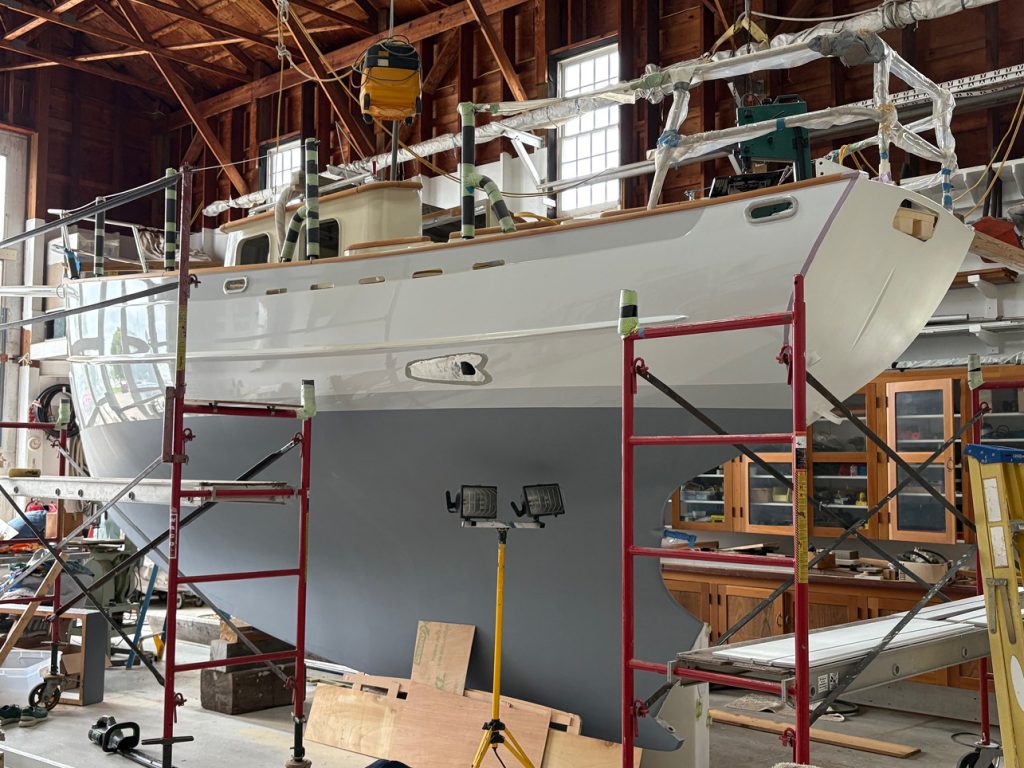
Virginia, her hull handcrafted in aluminum by builder John Corjia, takes shape.
She is aluminum, mostly pre-2024 vintage aluminum. Her name is Virginia. She is waiting patiently to be fully built out in a high shed in a boatyard in Mystic, CT, known as Fort Rachel. This is a yard south down the Mystic River as it flows past Noank toward Fishers Island. In that yard facing south is a high shed, probably 75 feet long by 40 feet wide. Virginia is in there, cool grey and tan accents to a creamy hull. She’s about 25 feet long on deck, 8 feet wide, draws a little over 5 feet and when finished, should weigh about 12,000 pounds.
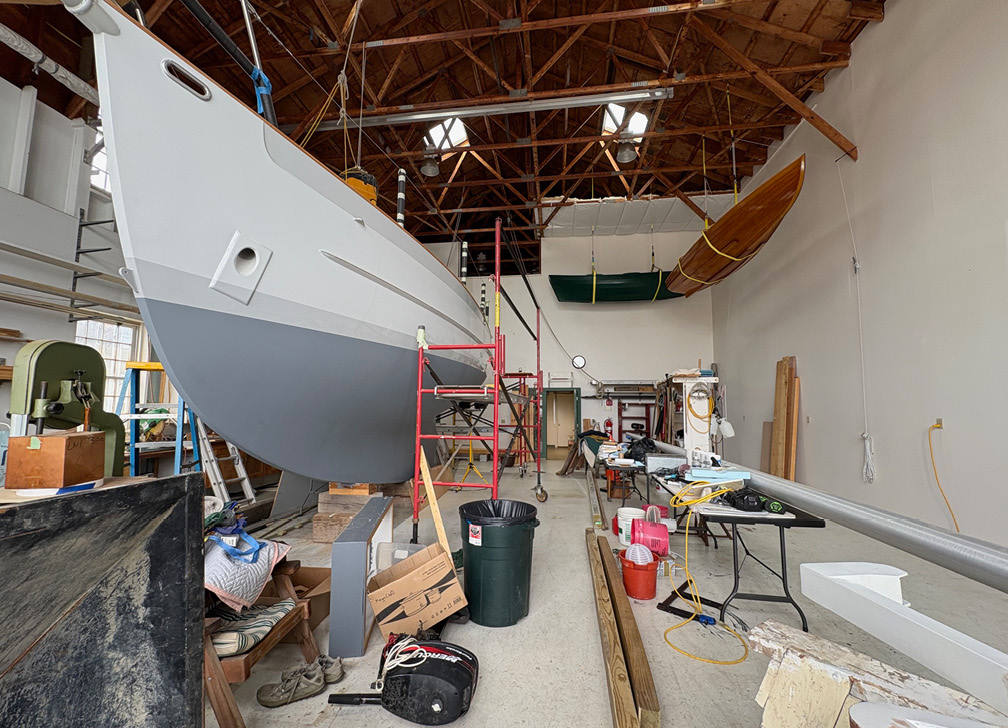
Old meets new in John’s shed, as Virginia shares space with vintage woodies.
Virginia is a family affair. She is the new design of the builder’s father. She is a yacht known in historical design terms as the “English Cutter.” The son and solo home boatbuilder, John Corija (pronounced “Core-asia” from his native Croatian), hopes to push her out of the shed completed in 2025. With interior and complicated gaff rig still to come, John’s wish would appear to require a djinn or a genie.
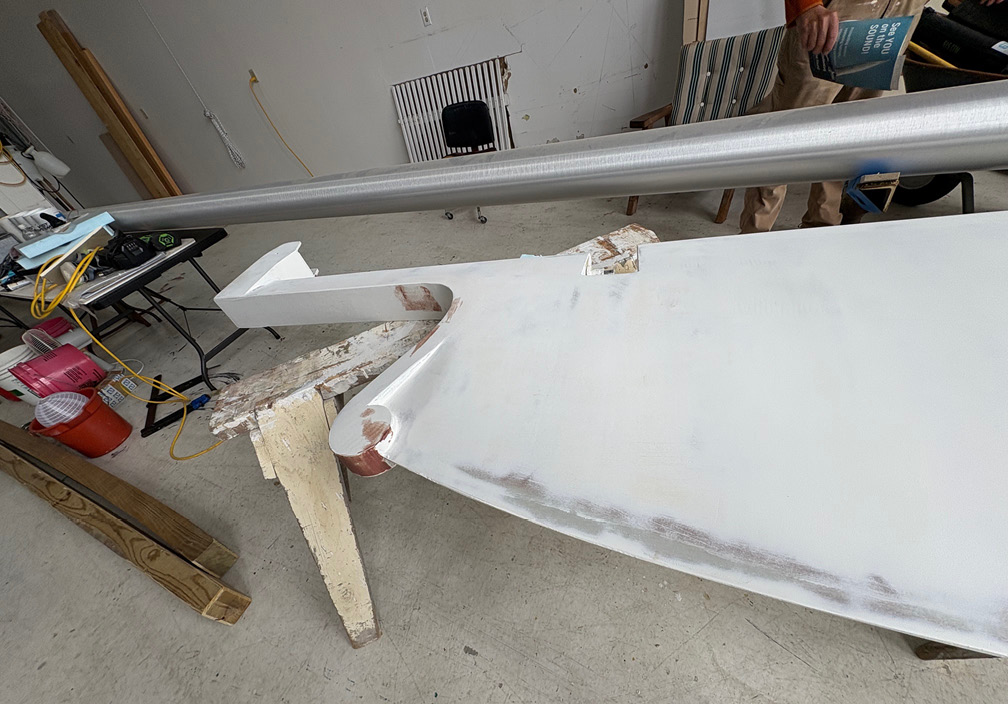
Virginia’s rudder is a modern blade with a classic flourish.
John was generous to put down his tools and tell us the origin story of Virginia. John’s father started her in the 1990s, beginning with a design that had its roots in the yachting experiment of the first royal yachtsman, Charles II, in the late 17th century.
The English Cutter, the King and the Clyde
In two previous issues we have explored the Clyde, the northwest hub of Scottish yachting in the vicinity of Glasgow. What the catboat and the schooner were to North America, the English Cutter has been to the Clyde. The cutter had her roots in the boats of Charles II, who was an enthusiastic waterman dedicated to pleasure afloat. In Franco Giorgetti’s Sailing Yachts, we learn that the royal inventor of yachting “during his 25-year reign… commissioned the building of no less than 26 yachts… one of the most remarkable was without doubt, the “Fubbs,” built toward the end of the seventeenth century at Greenwich with an overall length of 80 feet, a beam of 21 feet and a weight of 150 tons. This very fast vessel was distinguished by a ketch rig that Charles II claimed to invent.
Forty-six decades after the Yachting King’s demise, the basic elements of the cutter designs evolved from the barges of the Thames. The 19th century design came from fishing smacks, with a bluff but sturdy bow to handle the Irish Sea, low sheer gunwales and a powerful, flexible gaff rig with a bowsprit to handle two jibs. The local smugglers in Northern Scotland matched wits with the authorities to produce effective designs that excelled in rough water and variable Clyde breezes.
To our eye, the English Cutter design is reflected directly and honestly in the lines and features of John Corija’s 2025 Virginia.
Franco Giorgetti writes in his Sailing Yachts, “…cutters were originally defined more by their function than their rig: a cutter was a boat carried by the naval vessels used to counter the activities of smugglers and the term was later adopted to describe any kind of craft whose strong suit was speed rather than cargo capacity…
“Cutter came be used to describe a kind of yacht very common in British water; fairly narrow, with a deep draught and rigged with a single mast and a long bowsprit to carry more than one jib.
Still today the 19th century English cutter has immense appeal and represents a form, both in terms of hull shape and rigging, that had finally freed itself of the trapping(s) of the working boat, the English cutter could only be used for recreational sailing.”
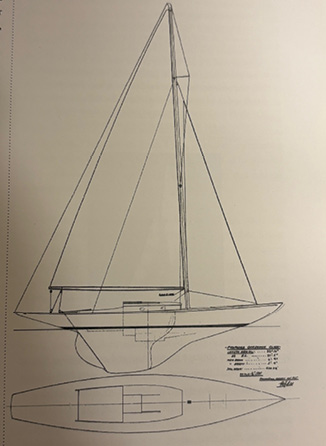
A draft proposal by Bjorn Aase for a racing boat that became the International One Design
In the picture published in the book, one sees a vertical bow, a very narrow hull, a running bowsprit, low over the water, black painted sides. That is the English cutter in the 1880s and ‘90s as steered by the Barr Brothers, the ace boat drivers of their native Clyde fjord, a rugged body of cold salt water stretching southwest to the Irish Sea from their 19th century Glasgow.
John Barr made a career of sailing the powerful, graceful yachts from the William Fife yard in Fairlee on the southeastern side of the Firth of Clyde. It was John, ten years the elder, who pushed his half-brother Charley to come to America where he would become the hired gun of one Nathanael Greene Herreshoff for his 1890s America’s Cup designs. It was Charley that piloted the largest of Captain Nat’s rockets, Reliance.

Allegra was built in 1936.
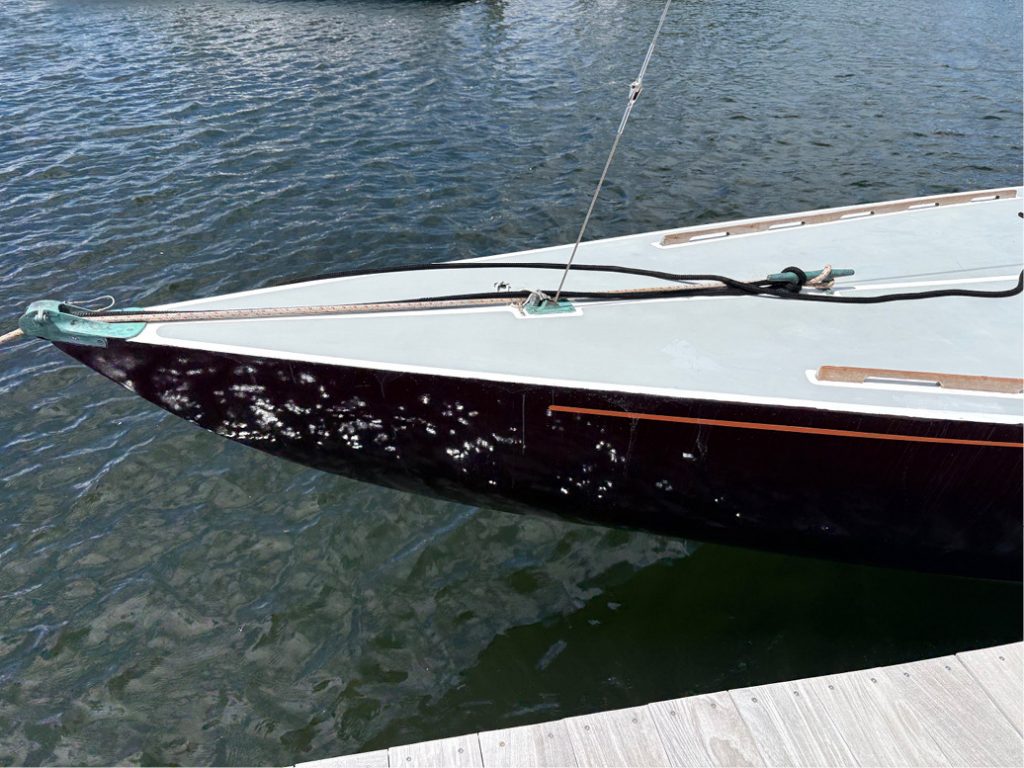
Gleaming topsides on Norwegian Wood
Virginia – All in the Corija Family
Today’s Virginia is a rare example of a metal cutter, with do-it-yourself aluminum. construction. As fair as any fiberglass, the hull sounds metal when rapped. John C. formed the hull strips by hand using a pneumatic press in the corner of the shed. It is a painstaking and demanding process, and he did it alone. Most of us have a hard time compacting a soda can. Virginia represents about 5 tons of meticulously bent metal, enough for a little over 350,000 cans (at 65,000 cans per ton) The topsides are framed by a long, gracefully arching strake to toss the water like a Ray Hunt V throws a wave. John talks wistfully about the hundreds of hours of sanding, filling, levelling, fairing and such to achieve Virginia’s finish
We examined the modernized features, hefty cockpit and deck drains. The rudder could be from an ocean racer. It is a long, tapered modern white blade with a whimsical carved classic flourish on the top, as if the classicist L. Francis Herreshoff had lent a hand.
The Corija shed is a case study in the ways of the home-grown boat builder. Every corner has a neat pile of woody bits. A workbench of WEST System containers sits patiently. John is clearly having fun. We had fun poking around. “I have some more to do, but the next step is the gaff rig,” said John. “It’s very hard to plan out.” A 50-foot tube of raw aluminum runs north south almost the length of the high bay work shed. “I’m getting in a rigger from Essex…and I don’t do electrical. Everyone says, ‘Do not do the electrical,’ and I second that.”
Wherry and Rowboat
Not many boatbuilding shacks have vintage rowing boats hanging from the ceiling like planes in an aviation museum. John has two classic small craft up in the northeast corner. He explained that he acquired them when the Mystic Seaport Museum (MSM) had its periodic housecleaning. John Gardiner at MSM established the small boat acquisition program in 1969 to gather up local historic boat types like canoes, skiffs and launches. Maynard Bray continued that effort, working with museums like the Antique Boat Museum in Clayton, NY in the St. Lawrence region.
The two boats decorating John’s shed ceiling were from those collections. Running north-south is a John Gardiner-designed rowing skiff, lapstrake planked with two long battens on the bottom for pulling up and over an uneven shore. The skiff was for sale and now has a new owner. Running east-west, and not for sale, is a green-stained salmon wherry, reminding me of Northwest native American craft. The long lines of the wherry and her low freeboard made for easy rowing and pulling up nets. She would have a flat bottom for beaching.
“I got a very good price,” said John with a twinkle in his eye. “They’ve called me and asked if I want to sell her back.” He shook his head. We promised to check up on Virginia’s progress, both her painstakingly executed finish and, just as important, John’s sharp deal for the skiff.
Saga to Allegra: The Journey of a 90-year-old IOD
Walking out of John’s shed and heading south, 50 yards away across the parking lot was Allegra. She is a 1936 International One Design woodie, part of a storied fleet of one-design racing keelboats. Commissioned by Cornelius Shields, Sr. in 1935 from the board and yard of Bjorn Aase, she was the progeny of a Bermudian Six Meter named Saga. Delivered with twenty-four others of her kind to members of the Larchmont Yacht Club in Larchmont, New York, she spent her early years on Long Island Sound.
Allegra came north to Fishers Island in the 1960s when the LYC fleet flagged and the enthusiasm for one design keelboats overcame members of Fishers Island Yacht Club, who had experimented with a handful of other designs before settling on the IOD. It’s been a fruitful relationship, with multiple World Champions, in particular in the form of Norwegian Wood of John Burnham and crew. My good friend, Clem Wood, former Harvard Sailing Team Captain, winters his boat next to the “Wood” across the Port Rachel lagoon.
We knew of Allegra when we advised on the revival of a “black shoe blue” colored hull built in Norway in 1959 for the sailing school operated by Herman Whitton, Jr. in Oyster Bay. “That story and photoset was featured in the April 2021 article on “The Etesian Restoration.”
The origin story of the IOD Class is told in the 2012 publication of The Saga of the International One Design. In this handsome coffee table book, commissioned by the class for its 75th anniversary, a trio of writers tell the IOD story. Written by Alessandro Vitelli with editorial direction from Herb Motley, my choice for the modern Godfather of the IOD class, the book is a superb collectible account of America’s oldest one-design keelboat (with apologies to the Star). Photo collections, most notably from the Rosenfeld family, inevitably feature the IOD. Generations of sailors have marveled at IOD depicted racing in big and very small winds by the Rosenfelds.
Allegra: Born 1936, reincarnated 2025
Allegra is among that first batch of boats ordered from Bjorn Aase. Corny Shields was charged with identifying and getting built a keelboat design to replace the club’s aging fleet of Sound One Designs. On a 1935 trip to Bermuda, he saw Saga and commissioned Aase to modify her design for the light, variable Long Island Sound breezes. Several iterations of plans later, the IOD design was born.
“Unquestionably the Long Island Sound order for 25 boats provided a solid basis for launching the project…. The first four IODs to land in the New World arrived in December, 1936. Today, the IOD is represented in Norway, Sweden, the UK, Bermuda, and Nova Scotia.”
The Etisian Project: 2021
In 2021, a group from Stonington, Connecticut purchased a vintage IOD with a very different background from Allegra; she was a generation younger (1959 vs 1936). The Etisian project (named for a Greek wind) was to take an Aase-built IOD and return her to racing form. The June 2021 WindCheck has that story. But did we know what happened to Allegra?
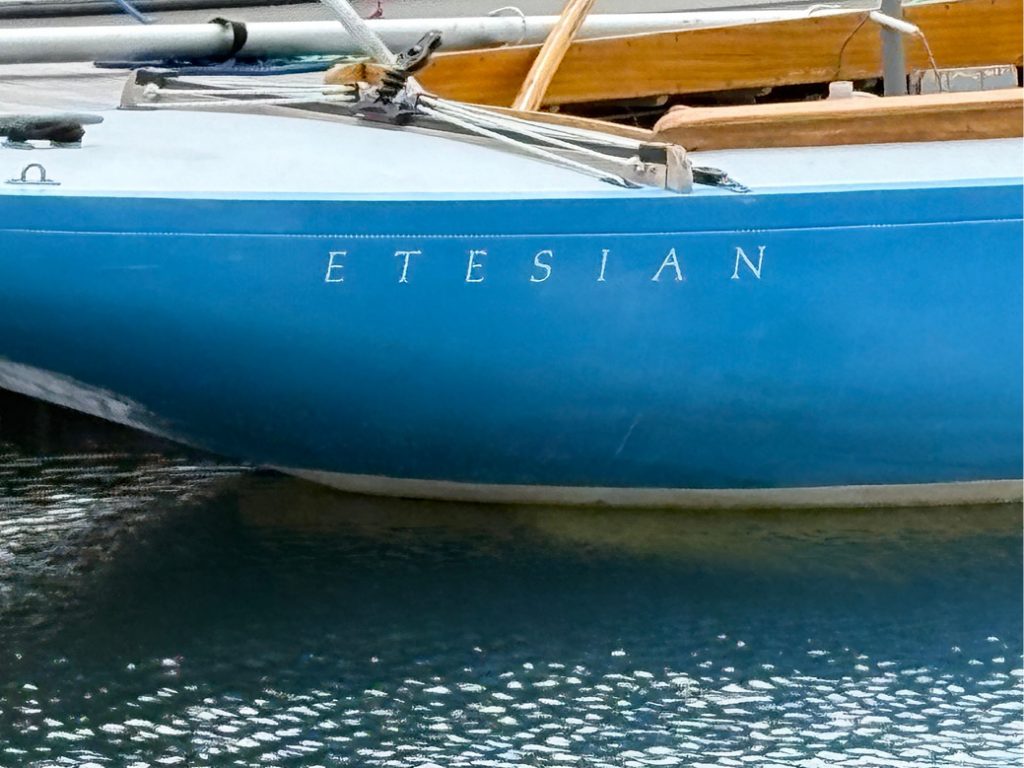
Etesian
The artisan who splined and faired the 62-year-old Etisian is Jim Thompson, a builder with a reputation for taking on the toughest of cases. Back in 2021 with the launch of Etisian, we understood he would be undertaking the restoration of what he called ‘the family boat.’ We visited him at his base in Safe Harbor Newport Shipyard repeatedly in the winter and spring of 2021 to see the progress. In June, we got the call. Etisian was ready to go. We collected the sails and equipment to stuff in the back of a compact station wagon. This was no Suburban; we most closely resembled a circus clown car.
We drove to Newport where Etisian was sharing dock space with giga yachts like Rebecca, but she was getting all the attention. COVID was barely behind us and Jim had two large powerboat projects as well as his own partner’s boat to prepare. No word on Allegra. We sailed off from Newport some 41 miles around Point Judith, west along the shoreline to home base in Stonington. We forgot all about Allegra…until there we were looking at her up on blocks at Fort Rachel with what appeared to be a pristine Imron topsides job; one in which to see your reflection. All in white with an old bronze painted keel, she reminded us of an ivory Greek caryatid. Eighty-nine years old, from the outside at least, but refurbished like new.
We wonder what Jim Thompson is up to. Will he, the shoemaker’s son, finally get Top-Siders of his own? Will she be floated? Will she race? We hope to report in a future piece. ■




